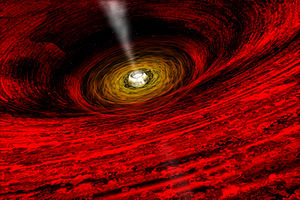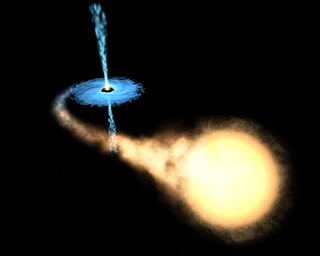
X-ray binaries are a class of binary stars that are luminous in X-rays. The X-rays are produced by matter falling from one component, called the donor, to the other component, called the accretor, which is very compact: a neutron star or black hole. The infalling matter releases gravitational potential energy, up to several tenths of its rest mass, as X-rays. The lifetime and the mass-transfer rate in an X-ray binary depends on the evolutionary status of the donor star, the mass ratio between the stellar components, and their orbital separation.
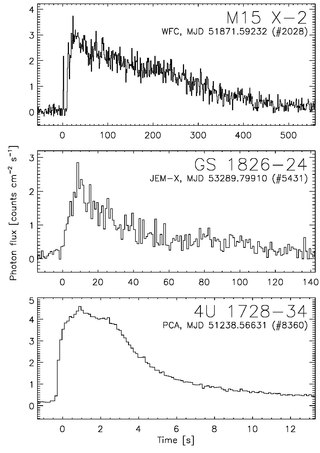
X-ray bursters are one class of X-ray binary stars exhibiting X-ray bursts, periodic and rapid increases in luminosity that peak in the X-ray region of the electromagnetic spectrum. These astrophysical systems are composed of an accreting neutron star and a main sequence companion 'donor' star. There are two types of X-ray bursts, designated I and II. Type I bursts are caused by thermonuclear runaway, while type II arise from the release of gravitational (potential) energy liberated through accretion. For type I (thermonuclear) bursts, the mass transferred from the donor star accumulates on the surface of the neutron star until it ignites and fuses in a burst, producing X-rays. The behaviour of X-ray bursters is similar to the behaviour of recurrent novae. In the latter case the compact object is a white dwarf that accretes hydrogen that finally undergoes explosive burning.
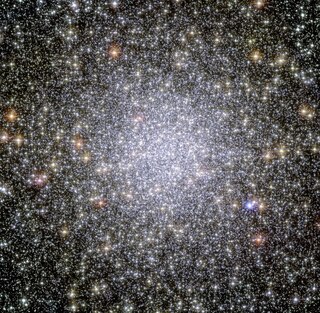
47 Tucanae or 47 Tuc is a globular cluster located in the constellation Tucana. It is about 4.45 ± 0.01 kpc (15,000 ± 33 ly) away from Earth, and 120 light years in diameter. 47 Tuc can be seen with the naked eye, with an apparent magnitude of 4.1. It appears about 44 arcminutes across including its far outreaches. Due to its far southern location, 18° from the south celestial pole, it was not catalogued by European astronomers until the 1750s, when the cluster was first identified by Nicolas-Louis de Lacaille from South Africa.

A transient X-ray source first discovered in 1996 by the Italian-Dutch BeppoSAX satellite, SAX J1808.4−3658 revealed X-ray pulsations at the 401 Hz neutron star spin frequency when it was observed during a subsequent outburst in 1998 by NASA's RXTE satellite. The neutron star is orbited by a brown dwarf binary companion with a likely mass of 0.05 solar masses, every 2.01 hours. X-ray burst oscillations and quasi-periodic oscillations in addition to coherent X-ray pulsations have been seen from SAX J1808.4-3658, making it a Rosetta stone for interpretation of the timing behavior of low-mass X-ray binaries.
Scorpius X-1 is an X-ray source located roughly 9000 light years away in the constellation Scorpius. Scorpius X-1 was the first extrasolar X-ray source discovered, and, aside from the Sun, it is the strongest apparent source of X-rays in the sky. The X-ray flux varies day-to-day, and is associated with an optically visible star, V818 Scorpii, that has an apparent magnitude which fluctuates between 12-13.
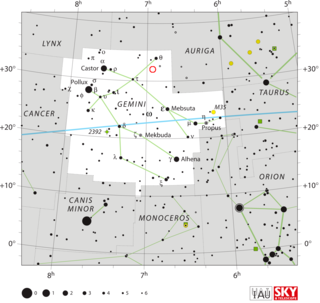
DN Geminorum or Nova Geminorum 1912 was a classical nova which lit up in 1912 in the constellation Gemini. It was discovered by Norwegian variable star observer Sigurd Einbu on March 12, 1912 before reaching peak brightness, which allowed early-stage spectra to be collected by Yerkes Observatory. The nova reached a maximum brightness of around 3.5 mag before declining, which means it was visible to the naked eye. Its brightness decreased over the following 36 days by 3 magnitudes as it gradually faded from sight. The light curve saw two maxima a few months after the outburst, along with strong oscillations. Today its brightness is visual magnitude 15.5.

An ultraluminous X-ray source (ULX) is an astronomical source of X-rays that is less luminous than an active galactic nucleus but is more consistently luminous than any known stellar process (over 1039 erg/s, or 1032 watts), assuming that it radiates isotropically (the same in all directions). Typically there is about one ULX per galaxy in galaxies which host them, but some galaxies contain many. The Milky Way has not been shown to contain a ULX, although SS 433 may be a possible source. The main interest in ULXs stems from their luminosity exceeding the Eddington luminosity of neutron stars and even stellar black holes. It is not known what powers ULXs; models include beamed emission of stellar mass objects, accreting intermediate-mass black holes, and super-Eddington emission.

OJ 287 is a BL Lac object 3.5 billion light-years from Earth that has produced quasi-periodic optical outbursts going back approximately 120 years, as first apparent on photographic plates from 1891. Seen on photographic plates since at least 1887, it was first detected at radio wavelengths during the course of the Ohio Sky Survey. It is a supermassive black hole binary. The intrinsic brightness of the flashes corresponds to over a trillion times the Sun's luminosity, greater than the entire Milky Way galaxy's light output.

NGC 3201 is a low galactic latitude globular cluster in the southern constellation of Vela. It has a very low central concentration of stars. This cluster was discovered by James Dunlop on May 28, 1826 and listed in his 1827 catalogue. He described it as "a pretty large pretty bright round nebula, 4′ or 5′ diameter, very gradually condensed towards the centre, easily resolved into stars; the figure is rather irregular, and the stars are considerably scattered on the south".
In X-ray astronomy, quasi-periodic oscillation (QPO) is the manner in which the X-ray light from an astronomical object flickers about certain frequencies. In these situations, the X-rays are emitted near the inner edge of an accretion disk in which gas swirls onto a compact object such as a white dwarf, neutron star, or black hole.

Vela X-1 is a pulsing, eclipsing high-mass X-ray binary (HMXB) system, associated with the Uhuru source 4U 0900-40 and the supergiant star HD 77581. The X-ray emission of the neutron star is caused by the capture and accretion of matter from the stellar wind of the supergiant companion. Vela X-1 is the prototypical detached HMXB.

A quasi-star is a hypothetical type of extremely massive and luminous star that may have existed early in the history of the Universe. Unlike modern stars, which are powered by nuclear fusion in their cores, a quasi-star's energy would come from material falling into a black hole at its core.
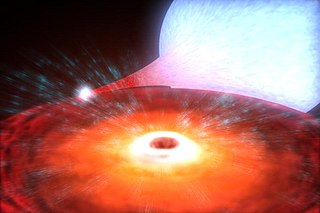
XTE J1650-500 is a binary system containing a stellar-mass black hole candidate and 2000–2001 transient binary X-ray source located in the constellation Ara. In 2008, it was claimed that this black hole had a mass of 3.8±0.5 solar masses, which would have been the smallest found for any black hole; smaller than GRO 1655-40, the then known smallest of 6.3 M☉. However, this claim was subsequently retracted; the more likely mass is 5–10 solar masses.

GX 339-4 is a moderately strong variable galactic low-mass X-ray binary (LMXB) source and black hole candidate that flares from time to time. From spectroscopic measurements, the mass of the black-hole was found to be at least of 5.8 solar masses.

V404 Cygni is a microquasar and a binary system in the constellation of Cygnus. It contains a black hole with a mass of about 9 M☉ and an early K giant star companion with a mass slightly smaller than the Sun. The star and the black hole orbit each other every 6.47129 days at fairly close range. Due to their proximity and the intense gravity of the black hole, the companion star loses mass to an accretion disk around the black hole and ultimately to the black hole itself.

An accretion disk is a structure formed by diffuse material in orbital motion around a massive central body. The central body is most frequently a star. Friction, uneven irradiance, magnetohydrodynamic effects, and other forces induce instabilities causing orbiting material in the disk to spiral inward toward the central body. Gravitational and frictional forces compress and raise the temperature of the material, causing the emission of electromagnetic radiation. The frequency range of that radiation depends on the central object's mass. Accretion disks of young stars and protostars radiate in the infrared; those around neutron stars and black holes in the X-ray part of the spectrum. The study of oscillation modes in accretion disks is referred to as diskoseismology.

GS 2000+25 is an X-ray binary system in the constellation Vulpecula, consisting of a late K-type star and a black hole. It is also an X-ray nova.
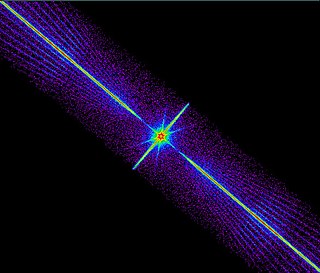
XTE J1118+480 is a low-mass X-ray binary in the constellation Ursa Major. It is a soft X-ray transient that most likely contains a black hole and is probably a microquasar.

PSR J0952–0607 is a massive millisecond pulsar in a binary system, located between 3,200–5,700 light-years (970–1,740 pc) away from Earth in the constellation Sextans. It holds the record for being the most massive neutron star known as of 2022, with a mass 2.35±0.17 times as much as the Sun—potentially close to the Tolman–Oppenheimer–Volkoff mass upper limit for neutron stars. The pulsar rotates at a frequency of 707 Hz, making it the second-fastest-spinning pulsar known, and the fastest-spinning pulsar that is located in the Milky Way.

